Sensor Sweep: Jack Vance, Pournelle, Robert McCammon, Manhunt
Monday , 29, August 2022 Sensor Sweep 1 CommentCinema (Looper): Let’s not mince words … “John Carter” was an okay movie. Released in 2012 by Disney and based on a series of books written by Edward Rice Burroughs — yes, the same author whose work led to Disney’s “Tarzan” — almost exactly a century prior, the science fiction blockbuster film was intended to be a box office epic, perhaps on the same level as “Star Wars.”
Writers (Goodman Games): Jack Holbrook Vance was summoned into this world just over a century ago in San Francisco on August 28, 1916. A writer of multiple genres, he is best known to fans of Dungeons and Dragons for his Dying Earth novels, one of the inspirations for the magic system, often called ‘Vancian’, in which magic-users memorize spells from their librams, and once cast, forget them for the day. Magic users in D&D also have a limited number of spell ‘slots,’ a nod to the incantations of the dying earth being so complex and mind-bending.
world just over a century ago in San Francisco on August 28, 1916. A writer of multiple genres, he is best known to fans of Dungeons and Dragons for his Dying Earth novels, one of the inspirations for the magic system, often called ‘Vancian’, in which magic-users memorize spells from their librams, and once cast, forget them for the day. Magic users in D&D also have a limited number of spell ‘slots,’ a nod to the incantations of the dying earth being so complex and mind-bending.
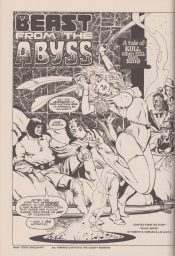 Robert E. Howard (Sprague de Camp Fan): “Black Abyss” is Lin Carter’s rewrite and completion of Robert E. Howard’s “The Black City.” This incomplete fragment by Robert E. Howard was probably written sometime in 1929. “Black Abyss” is the fourth story (not counting “Prolog”) in King Kull, Lancer Books, 1967.
Robert E. Howard (Sprague de Camp Fan): “Black Abyss” is Lin Carter’s rewrite and completion of Robert E. Howard’s “The Black City.” This incomplete fragment by Robert E. Howard was probably written sometime in 1929. “Black Abyss” is the fourth story (not counting “Prolog”) in King Kull, Lancer Books, 1967.
Horror (The Line Up): One of the most successful and enduring writers of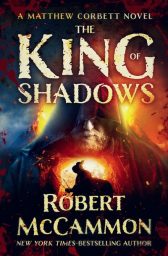 the “horror boom” that occurred between the 1970s and the early 1990s, Robert R. McCammon may be best known for his novel Boy’s Life. But throughout his career, he has written three other New York Times bestsellers, received a multitude of accolades—including several Bram Stoker and World Fantasy Awards—and drawn countless comparisons to Stephen King.
the “horror boom” that occurred between the 1970s and the early 1990s, Robert R. McCammon may be best known for his novel Boy’s Life. But throughout his career, he has written three other New York Times bestsellers, received a multitude of accolades—including several Bram Stoker and World Fantasy Awards—and drawn countless comparisons to Stephen King.
 Tolkien (Bounding Into Comics): A new report claims that Amazon Studios and Prime Video will declare their upcoming series The Lord of the Rings: The Rings of Power a victory “regardless of actual viewership.” Business Insider claims to have spoken to a number of anonymous insiders at Amazon Studios explaining what success for the series, which is estimated to have cost upwards of $1 billion for the first season, looks like.
Tolkien (Bounding Into Comics): A new report claims that Amazon Studios and Prime Video will declare their upcoming series The Lord of the Rings: The Rings of Power a victory “regardless of actual viewership.” Business Insider claims to have spoken to a number of anonymous insiders at Amazon Studios explaining what success for the series, which is estimated to have cost upwards of $1 billion for the first season, looks like.
D&D (Skulls in the Stars): Time for more old school Dungeons & Dragons,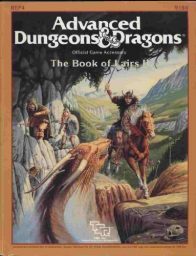 compiled from the threads I post on twitter! Without further ado, let us begin: Lords of Darkness, by Ed Greenwood et al. (1988). This is another one of those reference books that underwhelmed me as a teenager, but that I really love now!
compiled from the threads I post on twitter! Without further ado, let us begin: Lords of Darkness, by Ed Greenwood et al. (1988). This is another one of those reference books that underwhelmed me as a teenager, but that I really love now!
Writing (Wasteland & Sky): Even outside of Cannon, there has been a huge resurgence and interest in pulp-style action and adventure stories of the like that more or less died off in the 1990s. You can find all kinds of books talking about everything from movies to even video games, focusing on the pure entertainment they strove to deliver. It is an era even focused on by those who weren’t alive to experience it. This shows there is much to the time period.
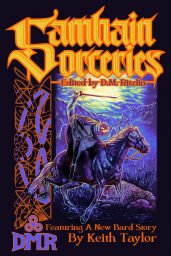 Forthcoming (DMR Books): DMR Books has a Halloween treat in store for fans of both horror and fantasy: the new anthology Samhain Sorceries! In these haunting tales of swords and sorcery, the dead will rise, dark rituals will be performed, and gateways to the afterworld will open. One of the more notable tales in this anthology is “Night of the Burning Ghost” by Keith Taylor, which features Felimid mac Fal, hero of the classic Bard series. Samhain Sorceries also includes stories by Adrian Cole, Matthew Pungitore, Harry Piper, and more.
Forthcoming (DMR Books): DMR Books has a Halloween treat in store for fans of both horror and fantasy: the new anthology Samhain Sorceries! In these haunting tales of swords and sorcery, the dead will rise, dark rituals will be performed, and gateways to the afterworld will open. One of the more notable tales in this anthology is “Night of the Burning Ghost” by Keith Taylor, which features Felimid mac Fal, hero of the classic Bard series. Samhain Sorceries also includes stories by Adrian Cole, Matthew Pungitore, Harry Piper, and more.
Conventions (Mystery File): 50 Years! I attended the first Pulpcon in 1972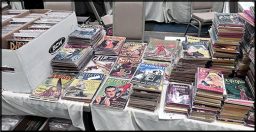 with my wife and we are among the very few survivors of this great, life changing convention. I say “life changing” because it seems that my entire life has revolved around pulp, book, and art collecting. Almost all my yearly vacations were scheduled to coincide with the convention dates and the show often overshadowed other major events in my life.
with my wife and we are among the very few survivors of this great, life changing convention. I say “life changing” because it seems that my entire life has revolved around pulp, book, and art collecting. Almost all my yearly vacations were scheduled to coincide with the convention dates and the show often overshadowed other major events in my life.
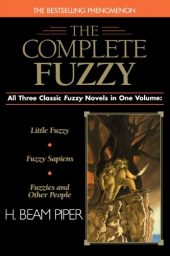 Science Fiction (Marzaat): Jerry Pournelle, H. Beam Piper’s friend, said, “It was those Fuzzy books that killed him! They got his hopes up, then dashed them. Beam’s plan was to write one book, or short story, in each century of his future history, not write three bloody Fuzzy novels, including one he could never sell.”
Science Fiction (Marzaat): Jerry Pournelle, H. Beam Piper’s friend, said, “It was those Fuzzy books that killed him! They got his hopes up, then dashed them. Beam’s plan was to write one book, or short story, in each century of his future history, not write three bloody Fuzzy novels, including one he could never sell.”
Science Fiction (With Both Hands): I stumbled on this great retrospective on Jerry Pournelle’s A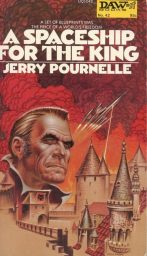 Spaceship for the King on the Castalia House blog while looking for something else. This particular post was mostly about Jerry’s influence on the Traveller RPG, but I want to look at some other things as well. Let’s take a snippet of what Jeffro said about it:
Spaceship for the King on the Castalia House blog while looking for something else. This particular post was mostly about Jerry’s influence on the Traveller RPG, but I want to look at some other things as well. Let’s take a snippet of what Jeffro said about it:
Gaming (Grognardia): I’ve opined before that the Fighting Fantasy series of solitaire gamebooks must have been very successful for both Penguin/Puffin Books and creators Steve Jackson and Ian Livingstone. Between 1982 and 1995, fifty-nine FF books appeared, penned by many different authors (including a few, as it turns out, by Jackson’s American namesake).
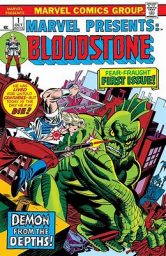 Comic Books (Glitter Night): MARVEL PRESENTS Vol 1 #1 (October 1975) Title: Dweller from the Depths (despite the title on the cover) Villains: The Possessor and the Dweller from the Depths
Comic Books (Glitter Night): MARVEL PRESENTS Vol 1 #1 (October 1975) Title: Dweller from the Depths (despite the title on the cover) Villains: The Possessor and the Dweller from the Depths
NOTE: This story introduced the character Ulysses Bloodstone, a mysterious monster hunter who has been alive for thousands of years, sustained by the fragment of an alien Blood Gem lodged in his chest. With his custom-made weapons and the paranormal powers granted to him by the Blood Gem, he has hunted down and destroyed countless monsters for millennia.
RPG (Mockman): As I’ve mentioned, I’m currently working on Dreamland, a roleplaying game based on HP Lovecraft and Lord Dunsany’s Dreamland stories (and much other stuff besides). Here’s a brief excerpt from the “Beasts” (or monsters) section, the description of zoogs. For my studies in Zoogery, and all the creatures of Dreamland, I was inspired by Kenneth Hite’s monster descriptions in “Trail of Cthulhu” in which he leaves several options of how a creature *might* be, and leaves it for the DM to decide and surprise their players.
Writing (DMR Books): About four months ago, I wrote a blog entry regarding ‘pastiches’ in the De Campian sense. There were several interesting comments on that post. While I thought I laid out my basic attitude toward pastiches fairly well, there are certainly various angles that I didn’t cover. It’s a complicated topic and, thanks to Spraguey, one fraught with a lot of emotional baggage. For those too lazy to click hyperlinks, I might as well quote myself. Here are my previous comments on ‘pastiches’:
D&D (Monsters and Manuals): A lot of D&D settings have what you might call open historicity. (By ‘historicity’, I mean simply the quality of having a history.) They are thought, like our own world, to have an origin, and a timeline that begins some time in the distant past and may go on indefinitely into the future. The timeline, note, does not have to be detailed – it simply has to be the case that there is a sense that events in the world follow on from one another in a chain of causation. Faerun, Krynn, Eberron, etc., all tend to be like this, as do most ‘fantasy heartbreaker’ worlds and those in high fantasy novels (such as Westeros).
A. Conan Doyle (Tentaclii): New on Librivox, Conan Doyle’s book The Last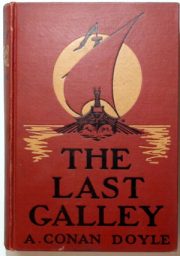 Galley, Impressions and Tales (1911). This is from before Doyle’s marked turn to spiritualism. Doyle writes in his introduction…The first half is made up of a series of pictures of the past … there is a region between actual story and actual history which has never been adequately exploited. I could imagine, for example, a work dealing with some great historical epoch, and finding its interest not in the happenings to particular individuals, their adventures and their loves, but in the fascination of the actual facts of history themselves.
Galley, Impressions and Tales (1911). This is from before Doyle’s marked turn to spiritualism. Doyle writes in his introduction…The first half is made up of a series of pictures of the past … there is a region between actual story and actual history which has never been adequately exploited. I could imagine, for example, a work dealing with some great historical epoch, and finding its interest not in the happenings to particular individuals, their adventures and their loves, but in the fascination of the actual facts of history themselves.
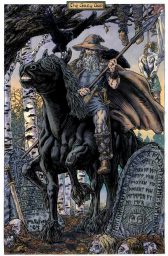 Misc (Frontier Partisans): One of the frontier-related pages I follow — Just Frontier Trash, 1750-1790 — kicked up an interesting description from traveler Henry Rowe Schoolcraft of a hunter in the Ozarks wearing “a short, greasy buckskin frock and a pointed old hat.” “Pointed Old Hat” conjures images from Middle Earth — Tom Bombadil and Gandalf. And we’re off…
Misc (Frontier Partisans): One of the frontier-related pages I follow — Just Frontier Trash, 1750-1790 — kicked up an interesting description from traveler Henry Rowe Schoolcraft of a hunter in the Ozarks wearing “a short, greasy buckskin frock and a pointed old hat.” “Pointed Old Hat” conjures images from Middle Earth — Tom Bombadil and Gandalf. And we’re off…
Pulp (Bloody Spicy Books): The Phantom Detective is probably no one’s favorite pulp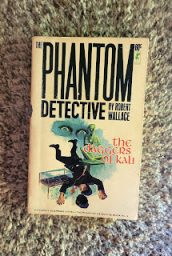 hero. Though he must have been plenty of folks back in the day because he outlasted the greats, i.e. The Shadow and Doc Savage. I have a feeling this is mostly because he’s not as outlandish or, well, memorable, giving his tales a mildly flavorful punch but generally more palatable for a general audience.
hero. Though he must have been plenty of folks back in the day because he outlasted the greats, i.e. The Shadow and Doc Savage. I have a feeling this is mostly because he’s not as outlandish or, well, memorable, giving his tales a mildly flavorful punch but generally more palatable for a general audience.
Crime Fiction (Chimney Sweep Reader): Manhunt 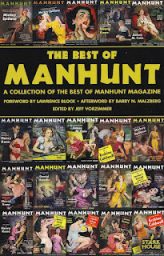 was acknowledged as the successor to Black Mask, which had stopped publishing the year before in 1951. It was a venue for high-quality crime fiction and by April of 1956 it was being billed as the “World’s Best-Selling Crime-Fiction Magazine.” This volume of stories is representative of Manhunt‘s contents and a must-read for fans of this genre. The editor, Jeff Vorzimmer, chose to replicate the contents of the 1958 paperback “The Best from Manhunt”, edited by Scott and Sidney Meredith, and of the 1959 British volume “The Bloodhound Anthology”. Together these stories represent over a third of the overall content of this volume.
was acknowledged as the successor to Black Mask, which had stopped publishing the year before in 1951. It was a venue for high-quality crime fiction and by April of 1956 it was being billed as the “World’s Best-Selling Crime-Fiction Magazine.” This volume of stories is representative of Manhunt‘s contents and a must-read for fans of this genre. The editor, Jeff Vorzimmer, chose to replicate the contents of the 1958 paperback “The Best from Manhunt”, edited by Scott and Sidney Meredith, and of the 1959 British volume “The Bloodhound Anthology”. Together these stories represent over a third of the overall content of this volume.
Crime Fiction (Paperback Warrior): In 1980, the top 15 list of all-time US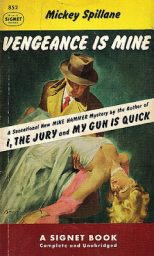 fiction bestsellers included seven novels by Mickey Spillane. That’s a true testament to the power and popularity of Spillane’s iconic private-detective, Mike Hammer. As I make my way through Spillane’s bibliography, I found that the Mike Hammer debut, I, the Jury (1947) left much to be desired. However, the book’s sequel, My Gun is Quick (1950), was nothing short of amazing with its masterful prose soaked with realism, impending doom, and emotional anguish.
fiction bestsellers included seven novels by Mickey Spillane. That’s a true testament to the power and popularity of Spillane’s iconic private-detective, Mike Hammer. As I make my way through Spillane’s bibliography, I found that the Mike Hammer debut, I, the Jury (1947) left much to be desired. However, the book’s sequel, My Gun is Quick (1950), was nothing short of amazing with its masterful prose soaked with realism, impending doom, and emotional anguish.
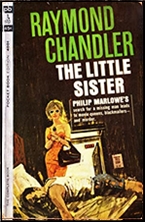 Crime Fiction (Mystery File): RAYMOND CHANDLER – The Little Sister. Philip Marlowe #5. Houghton Mifflin, hardcover, 1949. Reprinted many times. A mousy little young lady, Miss Orfamay Quest from smalltown Kansas, hires Philip Marlowe to find her long lost brother. She’s terribly proper and is afraid her brother may have succumbed to the sinful temptations of Los Angeles. The story’s as convoluted as Chandler’s usually are. But the patter is, for my money, the most hilarious of any of Marlowe’s adventures.
Crime Fiction (Mystery File): RAYMOND CHANDLER – The Little Sister. Philip Marlowe #5. Houghton Mifflin, hardcover, 1949. Reprinted many times. A mousy little young lady, Miss Orfamay Quest from smalltown Kansas, hires Philip Marlowe to find her long lost brother. She’s terribly proper and is afraid her brother may have succumbed to the sinful temptations of Los Angeles. The story’s as convoluted as Chandler’s usually are. But the patter is, for my money, the most hilarious of any of Marlowe’s adventures.
Fiction (Pulp Fiction Review): In the tradition of the great Lee Falk, creator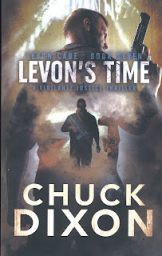 of the Phantom cartoon strip, “for those of us who came in late.” Chuck Dixon, one of the top comic book scripters in the country, started writing a series of vigilante thrillers featuring an ex-marine named Levon Cade. We were only vaguely aware of the paperbacks but hadn’t had to the opportunity to check them out until several years ago when the author surprised us with a copy of book # 8, “Levon’s Home.” We devoured it. Reviewed it and then when # 9, “Levon’s Hunt” came out we picked it up fast.
of the Phantom cartoon strip, “for those of us who came in late.” Chuck Dixon, one of the top comic book scripters in the country, started writing a series of vigilante thrillers featuring an ex-marine named Levon Cade. We were only vaguely aware of the paperbacks but hadn’t had to the opportunity to check them out until several years ago when the author surprised us with a copy of book # 8, “Levon’s Home.” We devoured it. Reviewed it and then when # 9, “Levon’s Hunt” came out we picked it up fast.
 Cinema (Stuff I Like): I don’t know much about Australian history, let alone that of its 19th-century frontier. I have seen Quigley Down Under – which I don’t like that much – and that’s about it. If that period was anything like it’s portrayed in The Proposition, directed by John Hillcoat and written by Nick Cave, it was irredeemably harsh and miserable. The effort to bring civilization suffered at the hands of the rich and the violent. As the quote above states, the Queensland Outback, the movie’s setting, was a place Europeans would have been better off avoiding.
Cinema (Stuff I Like): I don’t know much about Australian history, let alone that of its 19th-century frontier. I have seen Quigley Down Under – which I don’t like that much – and that’s about it. If that period was anything like it’s portrayed in The Proposition, directed by John Hillcoat and written by Nick Cave, it was irredeemably harsh and miserable. The effort to bring civilization suffered at the hands of the rich and the violent. As the quote above states, the Queensland Outback, the movie’s setting, was a place Europeans would have been better off avoiding.
T.V. (Bounding Into Comics): On July 29, Bounding into Comics reported that Global TV is beginning production on Robyn Hood, a series that is reimagining “the English archer of legend as a young, black, female ‘Gen Zer’.” Jessye Romeo will portray the eponymous character.
Horror (Nocturnal Revelries): I read The Festering, my first Guy N. Smith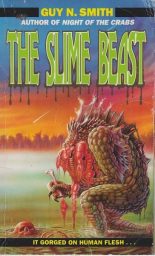 novel, a few weeks ago, and I greatly enjoyed it. I picked it because of its cover, and I decided that the next of Smith’s books I would read would be one of his more esteemed works. I chose The Slime Beast as I knew that the illustrious Centipede Press had reissued this one in a fine hardback edition.
novel, a few weeks ago, and I greatly enjoyed it. I picked it because of its cover, and I decided that the next of Smith’s books I would read would be one of his more esteemed works. I chose The Slime Beast as I knew that the illustrious Centipede Press had reissued this one in a fine hardback edition.
I still have a number of McCammon’s books left to be read, but I’ve been consistently impressed by what I have read of his work. Rip-off or not, Swan Song is a better all around book than The Stand. Boy’s Life is a modern classic. The Corbett books have great historical atmosphere. Etc. He seems to me a better observer of human nature than most of his peers.